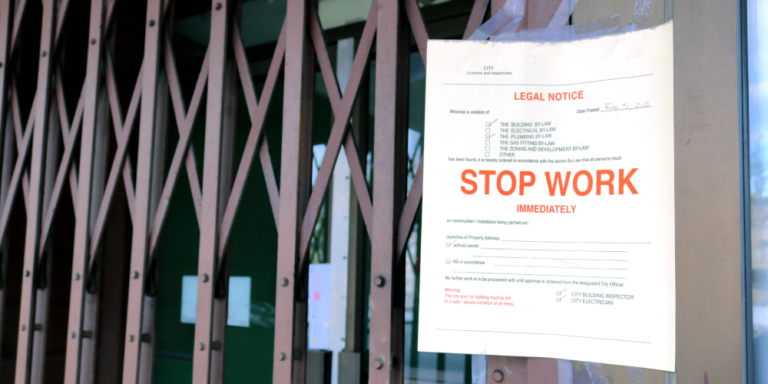

A stop work order is a legal tool project owners (or occasionally other parties) use to shut down work on a construction jobsite until the issue is fixed or the parties reach an agreement. Provisions for Stop work orders are typical in federal and state construction contracts, and are often included in private contracts as well.
Table of contents
A stop work order (SWO) is a contractual legal tool issued by project owners, inspectors, or government agencies to ensure safety and minimize the impact of contract breaches. When a stop work order is given, a project must shut down the affected sections’ operations until the problem has been resolved and an agreement is met by all parties involved.
An SWO can be issued for anything that deviates from the contract requirements, from health code violations to subcontractor payment issues. They should all be taken seriously and corrected as quickly as possible.
Generally speaking, your construction contract will determine whether or not you’re susceptible to a Stop Work Order while on a project. If an SWO clause is part of your contract, the owner or an agent of the owner can issue an SWO for any of the reasons outlined therein.
Essentially, if the inspector doesn’t like what they see, they can issue an SWO. These guidelines apply to most cities, give or take a detail or two.
Note that a stop work order is different from a stop notice, which is a tool used by contractors in the event that they are not paid.
Federal contracts use the Federal Acquisition Regulation (FAR) to govern non-commercially available goods and services like construction. These contracts almost universally use the FAR Stop-Work Order Clause (FAR 52.242-15), which says:
"The Contracting Officer may, at any time, by written order to the Contractor, require the Contractor to stop all, or any part, of the work called for by this contract for a period of 90 days after the order is delivered to the Contractor, and for any further period to which the parties may agree.
"The order shall be specifically identified as a stop-work order issued under this clause. Upon receipt of the order, the Contractor shall immediately comply with its terms and take all reasonable steps to minimize the incurrence of costs allocable to the work covered by the order during the period of work stoppage."
Free educational courses on Health & Safety, Data in Construction, and more. Earn Your Continuing Education Units (CEUs) for license renewals and career advancement with Procore.
![]()
Most state public works projects will also be subject to Stop Work Order provisions, typically for violations of contractor licensing, building permits, safety, or any other breach of the law.
For example, in California, the Contractor State Licensing Board (CSLB) has authority to issue a Stop Order where there is no workers’ compensation insurance coverage for employees.
The municipal or city government may govern these orders as well. Contractors should check their construction contract and local ordinances to understand the requirements and process after a Stop Work Order has been issued.
For example, NYC Department of Buildings states a Stop Work Order may occur when “inspectors determine the work is in violation of Construction Codes, Zoning Resolution, or any law or rule enforced by the Department; and when work on a site is being done in an unsafe manner.”
Not all SWOs require you to turn out the lights and lock the doors. Depending on what the issue is that caused the stop, you might receive a full or a partial order.
A full stop work order shuts down the entire jobsite. Everyone on the job has to pack it in and head home. There are a number of reasons why an agency might issue a full stop work order.
If there were engineering, design, or financial concerns, a stop work order will bring the site to a halt until the management is able to resolve the issue. Egregious safety violations could also result in a full stop work order.
A partial stop work order shuts down a portion of the jobsite, allowing other work to continue. This may be an option when there are issues with a certain contractor, a particular aspect of the design is changing, or there are safety issues that need addressing.
Regardless of the type of SWO, the only work typically allowed to continue is remedial work to address the issue at hand. All other work must cease right away.
SWOs can come at any time, from a variety of sources. They may be issued by a project owner, site manager, developer, contractor, or a governmental agency inspector. This is done for the benefit of both parties, to ensure contract compliance and, most importantly, safety.
An SWO is a tool that can be used to reduce the risk of injury and help create a healthy work environment. They are used to put an end to dangerous work conditions and ensure no health code violations continue.
When in place, an inspector can conduct a surprise visit and issue civic penalties if work continues under these conditions.
Contractor licensing and building permit violations also allow an SWO to halt work.
Be it on the federal, state, or private level, the stipulations of an SWO will be outlined in construction contracts. They can settle payment disputes, handle engineering changes or wait out production issues.
A stop work order clause gives the project’s top management the ability to stop work at any time for a variety of reasons, including: